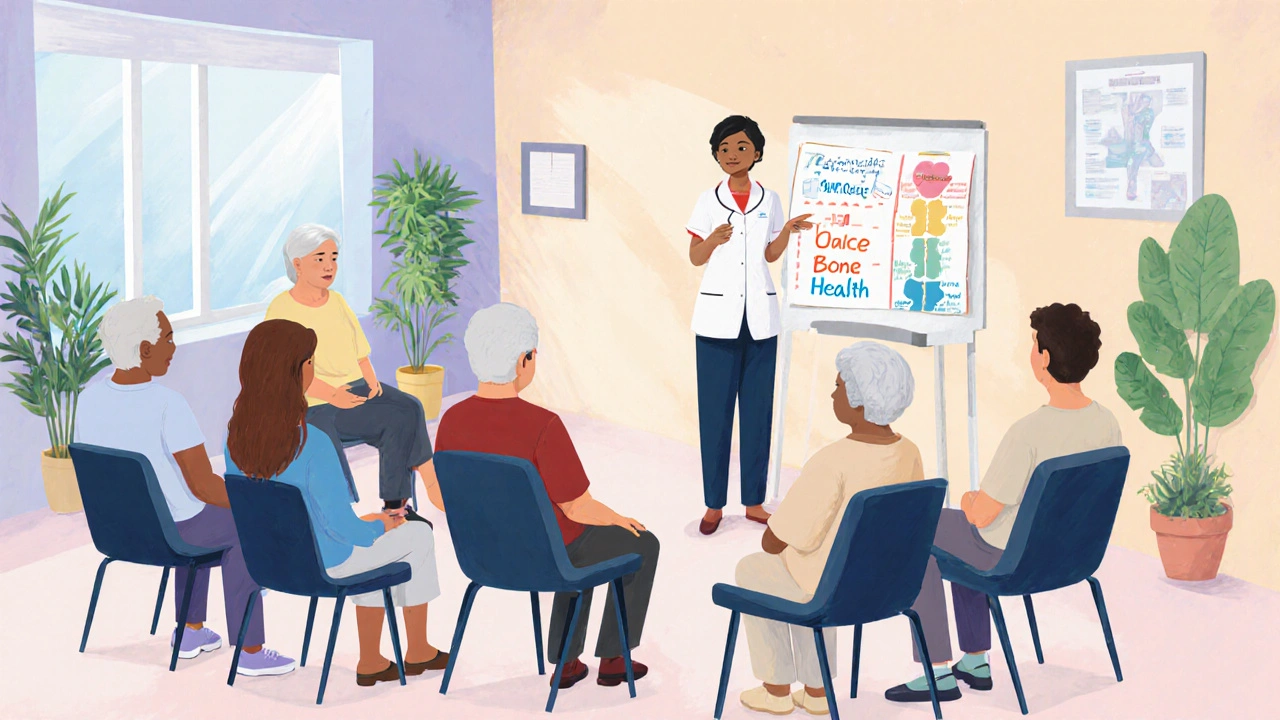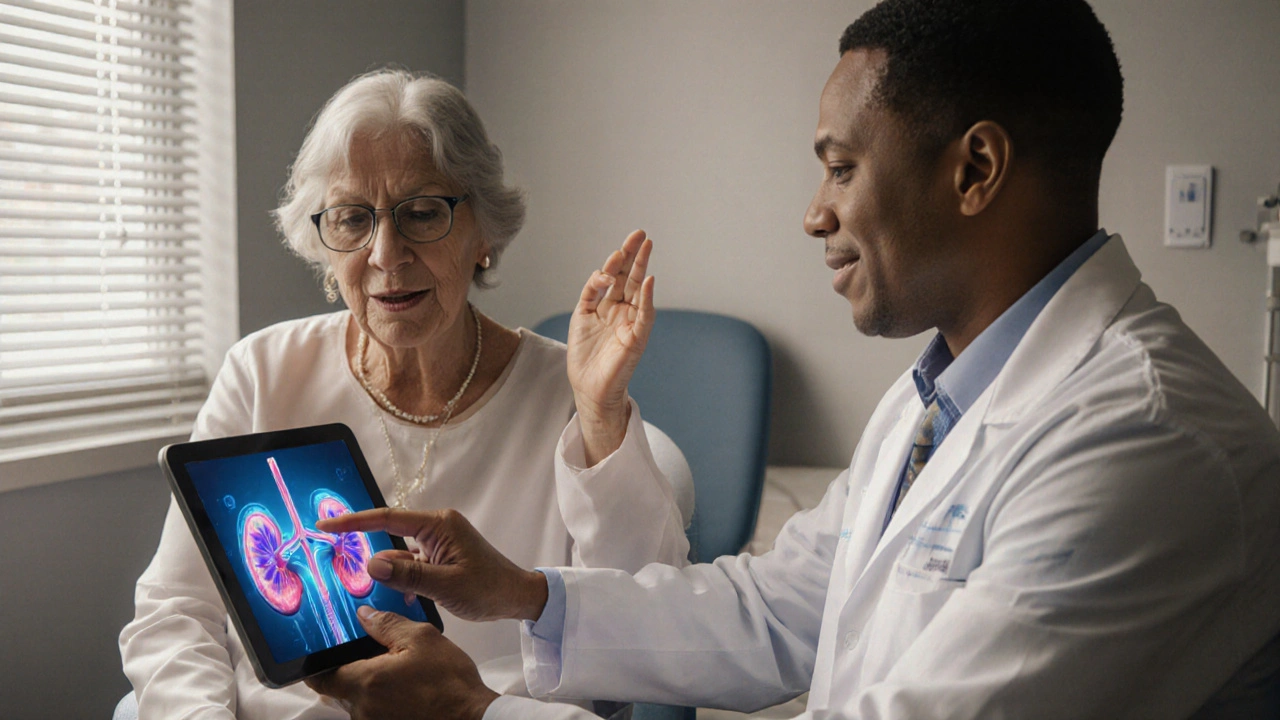When the parathyroid glands start overproducing hormone because the body can’t keep calcium and phosphate in balance, the result is secondary hyperparathyroidism. This condition shows up most often in people with chronic kidney disease, but anyone with persistent vitamin D deficiency or malabsorption can develop it. Without a clear understanding of why the disease happens and how daily choices affect the labs, patients often feel powerless and end up with avoidable complications.
What Exactly Is Secondary Hyperparathyroidism?
Secondary Hyperparathyroidism is a disorder where the parathyroid hormone (PTH) rises in response to low calcium, high phosphate, or low active vitamin D levels. Unlike primary hyperparathyroidism, the glands themselves aren’t the problem; they’re reacting to an external imbalance.
The most common driver is chronic kidney disease (CKD). Failing kidneys can’t convert vitamin D to its active form, nor can they excrete phosphate efficiently. The resulting high phosphate and low calcium trigger the parathyroids to secrete more PTH.
Other contributors include severe vitamin D deficiency, malabsorption syndromes, and certain medications that interfere with calcium metabolism. Over time, persistently high PTH levels cause bone resorption, vascular calcification, and a host of metabolic disturbances.
Why Patient Education Is a Game‑Changer
Understanding the why behind lab numbers turns passive patients into active partners. When they grasp how diet, dialysis, and medication interact, they’re more likely to stick to treatment plans, attend appointments, and report symptoms early.
Research from the National Kidney Foundation shows that patients who receive structured education have a 30% lower risk of hospitalizations related to bone and mineral disorders. Knowledge also reduces anxiety; a 2023 survey of 1,200 CKD patients found that those who felt “well‑informed” reported half the level of treatment‑related stress compared with those who felt left in the dark.
Key Topics Every Patient Should Master
- PTH - what it does, why it rises, and how it’s measured.
- Phosphate binders - why they’re needed, how to take them correctly, and common side effects.
- Calcimimetics - what they do, who qualifies, and dosing considerations.
- Dietary calcium and phosphate - foods to limit, portion strategies, and reading nutrition labels.
- Vitamin D supplementation - active vs. native forms, dosing schedules, and monitoring.
- Dialysis modalities - how hemodialysis and peritoneal dialysis impact mineral balance.
- Bone health - importance of bone mineral density testing and safe exercise.
- Cardiovascular risk - why vascular calcification matters and what lifestyle tweaks help.
Most Effective Ways to Teach Patients
| Method | Engagement | Retention (3‑month) | Best For |
|---|---|---|---|
| Printed pamphlet | Low | 40% | Quick reference, low‑tech settings |
| Group workshop | High | 68% | Patients who thrive on peer support |
| Interactive app | Very high | 75% | Tech‑savvy, younger demographics |
| One‑on‑one counseling | Medium | 60% | Complex cases, language barriers |
Studies show that interactive digital tools boost long‑term knowledge, but not every clinic can afford app development. A balanced approach-starting with a concise pamphlet, followed by a live workshop, and topped with a brief phone‑call check‑in-covers most bases.

Practical Tips for Clinicians
- Start the conversation early. Introduce the concept of bone‑mineral disorder at CKD stage 3, not just when labs explode.
- Use visual aids. Simple charts that map calcium, phosphate, and PTH trends help patients see cause‑and‑effect.
- Confirm understanding with teach‑back. Ask patients to explain how they’ll take phosphate binders with meals.
- If they miss steps, repeat the instruction using a different analogy.
- Provide written summaries after each visit. Highlight three actionable items-no more.
- Leverage multidisciplinary teams. Dietitians can tailor meal plans; pharmacists can clarify dosing schedules.
- Schedule brief follow‑ups (15minutes) focused solely on education, not labs.
When patients see their care team aligned around education, they feel the plan is cohesive rather than scattered.
Common Misconceptions to Clear Up
Many patients think “phosphate binders are just pills I swallow, nothing else matters.” In reality, timing matters: binders should be taken with each meal-not after, because they need food to latch onto phosphate.
Another myth is that “high calcium intake will fix low calcium labs.” Excessive calcium can actually worsen vascular calcification, especially when combined with high PTH. Balance, not overload, is the goal.
Finally, some believe “if my PTH goes down, I’m cured.” The underlying kidney dysfunction remains, so monitoring must continue indefinitely.
Patient Self‑Management Checklist
- Take phosphate binders with every main meal and snack.
- Record weekly calcium and phosphate lab numbers in a journal.
- Attend at least one education session per quarter.
- Ask your clinician about vitamin D status every 6months.
- Schedule bone density testing as advised (usually annually).
- Stay active: low‑impact exercises, 30minutes most days.
- Report new bone pain, muscle cramps, or skin itching promptly.
Checking these boxes builds confidence and keeps complications at bay.
Frequently Asked Questions
What triggers secondary hyperparathyroidism?
The main triggers are low calcium, high phosphate, and insufficient active vitamin D-most often seen in chronic kidney disease. Other factors include poor nutrition, certain medications, and malabsorption disorders.
Do phosphate binders really help?
Yes. By attaching to dietary phosphate in the gut, binders prevent its absorption, lowering serum phosphate and consequently reducing the stimulus for excess PTH release. Proper timing with meals is crucial for effectiveness.
Are calcimimetics safe for long‑term use?
Calcimimetics, such as cinacalcet, have been shown to lower PTH without raising calcium levels. Long‑term data indicate they reduce the need for surgical parathyroid removal and may lower cardiovascular events, but they can cause nausea and lower blood pressure, so regular monitoring is needed.
How often should I get my labs checked?
Most nephrology guidelines recommend checking calcium, phosphate, PTH, and vitamin D every 1‑3months for patients with advanced CKD. Frequency may increase if medication doses change or if labs drift out of target ranges.
Can lifestyle changes alone control secondary hyperparathyroidism?
Lifestyle measures-like dietary phosphate control, regular low‑impact exercise, and consistent vitamin D supplementation-greatly support medical therapy, but they rarely replace it. A combined approach yields the best outcomes.

Louie Hadley
September 28, 2025 AT 06:39
Really appreciate the focus on patient education here. When folks actually understand why their calcium or phosphate is off, they’re far more likely to stick with binders and diet tweaks. It also cuts down the anxiety that comes from seeing weird numbers on labs. I’ve seen patients become partners in care rather than passive recipients. Keep pushing those teaching‑back moments.
Ginny Gladish
September 29, 2025 AT 04:53
The article correctly outlines the pathophysiology of secondary hyperparathyroidism, yet it could benefit from a clearer distinction between active vitamin D analogues and native supplementation. Moreover, the statistical claim of a 30 % reduction in hospitalizations requires citation of the specific cohort and methodology. While the table compares educational modalities, the sample sizes for each method are omitted, limiting interpretability. Finally, inclusion of cost‑effectiveness analysis would strengthen the argument for digital tools.
Faye Bormann
September 30, 2025 AT 03:06
It’s tempting to think that throwing a pamphlet at a patient will magically fix their mineral bone disorder, but the reality is far messier. First, each individual’s health literacy varies wildly, and a one‑size‑fits‑all document often lands on the floor unread. Second, the timing of education matters; introducing complex concepts at stage 3 CKD is far more effective than waiting until the labs spike dramatically. Third, cultural dietary habits shape phosphate intake, so a generic “limit dairy” advice may be irrelevant for someone whose staple is fish sauce. Fourth, the emotional burden of chronic disease cannot be dismissed-patients who feel overwhelmed are less likely to adhere to any regimen, no matter how well‑explained. Fifth, the role of the multidisciplinary team is underappreciated; dietitians, pharmacists, and social workers each bring a piece of the puzzle that a single physician cannot cover alone. Sixth, the evidence that interactive apps improve three‑month retention is promising, yet many clinics lack the infrastructure to support app deployment, creating a disparity in care. Seventh, peer‑support groups have consistently shown to boost motivation, as patients see real‑world success stories from their own community. Eighth, the “teach‑back” method is not just a buzzword; it provides a concrete way to verify comprehension and correct misconceptions on the spot. Ninth, consistent follow‑ups, even brief ones, reinforce the education and allow for timely adjustments in binder timing or dosage. Tenth, monitoring tools like lab journals empower patients to visualize trends, turning abstract numbers into actionable insights. Eleventh, vitamin D supplementation must be tailored-active forms are necessary in advanced CKD, but over‑supplementation can precipitate hypercalcemia. Twelfth, calcimimetics, while effective, carry side‑effects that require patient awareness to avoid unnecessary discontinuation. Thirteenth, vascular calcification risk is not solely a laboratory issue; lifestyle factors such as smoking cessation and moderate exercise play a critical role. Fourteenth, the psychological component-addressing fear of progression and fostering self‑efficacy-should be woven into every educational encounter. Finally, a balanced strategy that layers printed material, interactive sessions, digital reinforcement, and personal coaching is the most realistic pathway to sustainable improvement in patient outcomes.
Kathy Butterfield
October 1, 2025 AT 01:19
Love how this breaks down the binder timing-super helpful! 😊
Zane Nelson
October 1, 2025 AT 20:46
While the enthusiasm for digital reinforcement is evident, one must consider the variability in access to technology among the CKD population. The argument would benefit from a stratified analysis of socioeconomic status, as the presumption of universal app adoption may inadvertently marginalize vulnerable subgroups. Moreover, the pedagogical framework underlying such tools warrants explicit description to assess its efficacy beyond mere engagement metrics.
Sahithi Bhasyam
October 2, 2025 AT 18:59
i think it's also imporant to mention that not evryone has th same diet!!;;; actually some popualtion have high phospate foods like soda and fast food,,, so the education shoud be tailored!! :)
mike putty
October 3, 2025 AT 17:13
Great points made here, and it’s encouraging to see how education can really shift outcomes. Keep sharing these practical tips, they make a big difference for patients trying to navigate their treatment plans.
Kayla Reeves
October 4, 2025 AT 12:39
The emphasis on patient agency is commendable, yet it glosses over the systemic failures that leave many without proper guidance. We must hold healthcare systems accountable for providing consistent, unbiased education rather than placing the burden solely on individuals.
Tara Timlin
October 5, 2025 AT 10:53
For clinicians looking to implement the suggested checklist, consider integrating a simple spreadsheet that auto‑calculates calcium‑phosphate product and flags values outside target ranges. This tool can be shared during appointments and patients can update it between visits, ensuring real‑time awareness of their status. Additionally, linking the spreadsheet to a reminder system for lab draws can improve adherence to the recommended 1‑3 month testing frequency.
Jean-Sébastien Dufresne
October 6, 2025 AT 09:06
Wow!!! This spreadsheet idea is brilliant!! It’s exactly the kind of practical, no‑nonsense solution that cuts through bureaucratic red‑tape!! 👍👍
Patrick Nguyen
October 7, 2025 AT 07:19
The article could also address the role of fibroblast growth factor‑23 in the pathogenesis, as it modulates phosphate handling and PTH secretion.
Patrick Bread
October 8, 2025 AT 02:46
Oh great, another reminder that we need to talk about FGF‑23-because we haven’t heard that one before.
Fionnuala O'Connor
October 9, 2025 AT 00:59
Keep up the good work educating patients it really makes a difference
Christopher MORRISSEY
October 9, 2025 AT 23:13
The integration of cultural considerations into patient education is a nuance that deserves deeper exploration. For instance, dietary phosphate sources differ markedly across regions, and recommendations must be adapted to local cuisines to achieve relevance and adherence. Furthermore, language barriers can impede comprehension; employing multilingual resources and visual aids can bridge this gap effectively. Collaboration with community leaders and patient advocacy groups also enhances trust and facilitates the dissemination of accurate information. Ultimately, a culturally sensitive approach not only respects patient diversity but also optimizes clinical outcomes in secondary hyperparathyroidism management.
Adam O'Rourke
October 10, 2025 AT 21:26
Sure, because cooking up a culturally perfect diet plan is totally simple 😂